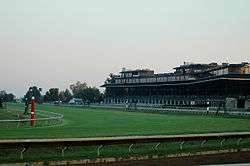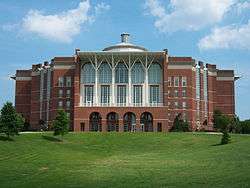Lextran
Lextran (officially the Transit Authority of the Lexington-Fayette Urban County Government[5]) is a public transportation bus system serving Lexington, Kentucky. It runs bus routes throughout the city which mostly converge in downtown at the Lexington Transit Center located at 220 East Vine.
| Parent | Lexington-Fayette Urban County Government |
|---|---|
| Founded | April 1972 |
| Headquarters | 200 West Loudon Avenue, Lexington, KY |
| Locale | Lexington and Fayette County |
| Service area | Lexington Urban Service Boundary [1] |
| Service type | Bus, Paratransit |
| Routes | 24[2] |
| Stops | 900[3] |
| Hubs | Lexington Transit Center |
| Fleet | 65[4] |
| Daily ridership | 17,265 (fiscal year 2012–2013)[3] |
| Fuel type | Mixed fleet (diesel, hybrid-electric, and electric)[3] |
| Operator | Transit Authority of LFUGC |
| Website | http://www.lextran.com |

Lextran provides public transportation in the form of buses and lift vans. It operates seven days a week with a total of 27 routes running from 5am until 12am. In addition to mainline and paratransit, Lextran contracts with the University of Kentucky and operates two routes around the campus.[6]
Even though Lexington and Fayette County are a consolidated government, Lextran does not provide service outside the Lexington city proper due to limited funding sources.[7]
History
Prior to Lextran's current existence, Lexington was served by numerous private transit systems. The first such system was the Lexington Railway Company streetcars which began operation in 1874[8] that used horse-drawn stagecoaches. The name changed to the Lexington Street Railway Company soon after to avoid confusion with the steam railroads. In 1890, the system was upgraded to streetcars and was referred to as the Kentucky Traction and Terminal Company. The streetcars ceased operations in 1938 when they were replaced by motorized buses under the Lexington Railway System name, which later became the Lexington Transit Corporation.
By the early 1970s, expenses associated with the operation of the motorized buses soon outstripped revenue for the Lexington Transit Corporation.[8] In April 1972, the Lexington-Fayette Urban County Government incorporated the system under the local government and renamed the system Lextran. In 1997, Lextran introduced the Lexington Bluegrass Mobility Office. It offers carpooling and vanpooling computer ridematching services and LexVan, a work commute vanpool leasing program.
In 2003–2004 Lextran bought 13 low-floor Thomas 35 feet buses and 6 low-floor Gillig 40 feet buses in an attempt to make the system more accessible to those with physical disabilities.
In 2004, the system received additional funding from a successful ballot initiative to implement a new property tax dedicated to helping fund the Lextran system.[10] Since the tax referendum passed, Lextran's system has grown by 50% and the number of passenger boardings and operators more than doubled.
In 2007, Lextran received several upgrades to its fleet of buses and facilities.[10] A renovation and expansion of the main Lextran facilities on East Loudon Avenue expected to cost $7.5 million Lextran was also seeking $3.1 million for new buses, $1.5 million for an Automated Vehicle Locator, and $800,000 to purchase new fare boxes. Phase one of the expansion project includes the construction of a new bus fuel and wash building at 109 West Loudon Avenue, along with upgrades to the restrooms and break room at the Lexington Transit Center. In addition, Lextran phased out all of their high-floor buses except for vans making all mainlines very accessible for those with disabilities.
In 2009, Lextran bought 3 Gillig Trolleys to start their trolley service, trolley service does not exist anymore; however, Lextran still uses these buses on lower ridership lines as they are the same size as the smaller low-floor Gillig 29 feet buses.
In 2011, Lextran purchased 2 new hybrid electric and 5 Gillig 29 feet buses to be used on lower ridership routes.
Between 2012 and 2014, Lextran purchased an additional 6 Gillig 40 feet buses
In 2016, the bus fleet will increase from 73 as of January 2016 to 76 with 5 new Proterra Electric Busses and 7 new Gillig CNG Busses with 9 of Lextran's oldest Thomas transit buses similar to the European Dennis Dart being retired. In addition, the new Lextran depot located at 200 West Loudon Avenue which was the location of an old General Electric manufacturing plant. This new depot will allow much more space for onsite bus and employee parking compared to the old depot. There is also more space for maintenance facilities which are all fully equipped for all of their buses. In addition, Lextran will be partnering with LFUCG to open a public CNG fueling station on the depot's property.
Current route list
- 1 Woodhill
- 2 Georgetown Road
- 3 Tates Creek Road
- 4 Newtown Pike
- 5 Nicholasville Road
- 6 North Broadway
- 7 North Limestone
- 8 Versailles Road
- 9 Eastland
- 10 Hamburg Pavilion
- 11 Richmond Road
- 12 Leestown Road
- 13 South Broadway
- 14B UK Blue Route
- 14W UK White Route
- 15 Red Mile (serving UK community)
- 16 Southland Drive
- 17 Northside Connector
- 18 Centre Parkway Connector
- 21 Blue Grass Airport-Keeneland
- 22 Mercer Road
- 24 Frankfort Pike
- 27 UK Yellow Route
- 51 Night Woodhill - Richmond
- 52 Night Georgetown - Leestown
- 58 Night Versailles - South Broadway
- 59 Night Eastland - North Limestone
Route frequency
Mainlines are considered to be routes 1-13 meaning that they run from a 5am departure usually in the middle of the route until the 12am arrival at the Transit Center. All mainlines run every 35 minutes during 3-4 hour rush hour in the morning and evening on a weekday. Some mainlines with lower ridership will reduce frequency during the day to only once every 70 minutes. All mainlines are bidirectional until 9:20pm departure where some routes with fewer riders at night become combo routes with a nearby line, with one traveling outbound and the other inbound. Fortunately with this most stops are still serviced, but some are forced to ride for much longer times than they usually do during the day. Saturdays on all lines have reduced frequency with only once per hour frequency. Sunday routes are similar to Saturday routes which run once an hour. Sunday schedules run from 5:45am until the 9:00pm arrival at the transit center. Route 16 is not considered a mainline bus, but still leaves from the Transit Center throughout the day (from 6:20am-7pm once per 70 minutes).

Routes 14 and 15 are circular routes that serve the UK Community and have the same fare as all other buses in Lextran; however, fare is free for all UK students and faculty. These lines are the most frequent running in Lextran from 7am-9pm every 4 to 12 minutes depending on the time of day. Line 15 specifically has a reputation for getting behind schedule and experiences what's known as Bus Bunching.
Routes 17 and 18 are connector routes that help those wanting to move laterally as opposed to having to go to downtown and back out. They also serve areas that are not normally served by mainlines but still have decent demand for ridership. Only Route 18 has service outside of peak hours and on Saturdays.
Routes 20, 21, and 23 only serve specific areas that are far from the Transit Center, because the areas they serve don't have high demand they only run during peak hours making them run only for a few hours every day. However, Route 21 now serves the busiest sections of Route 8 which will provide more frequency to and from downtown and direct access to Keeneland. Lextran is seeking to eliminate these lines and integrate them with existing mainlines.
2016 system overhaul
Because Lextran was seeking to serve high demand areas with better service, some less efficient lines were eliminated. These routes included 24, 25, and 31. Some of these eliminated lines were integrated with existing lines; however, most areas have become underserved. For those who live on mainlines there are fewer changes, for instance Sunday schedules will now be like day routes on weekdays. This means that there will not be combo routes. Lextran has hopes that this will improve convenience of service.
Route 20 Masterson Station had been very vocal with the possible elimination of their line.[11] Masterson Station was successful in keeping their bus route, including Route 17 Northside Connector. Route 16 Southland Drive was originally poised to run completely down Nicholasville Road to Southland Drive; however, it was changed to stop running through Commonwealth Stadium, and travel down Southland Drive to Harrodsburg and around Turfland Mall.
Fleet
| Year | Manufacturer | Model | Fleet Numbers | Fuel Type | Length of bus | Notes |
|---|---|---|---|---|---|---|
| 2004 | Gillig | Low Floor | 456-461 | Diesel | 40 feet | |
| 2005 | Gillig | Low Floor | 551-555 | Diesel | 40 feet | 553 retired |
| 2007 | Gillig | Low Floor | 766-782 | 40 feet | Diesel | |
| 2011 | Gillig | Low Floor Trolley | 30-32 | Hybrid | 35 feet | |
| 2011 | Gillig | Low Floor Hybrid | 790-791 | Hybrid | 35 feet | |
| 2011 | Gillig | Low Floor | 792-796 | Diesel | 29 feet | |
| 2011 | Ford | E-350 Cutaway | 47-51 | Diesel | Used on routes with low ridership. | |
| 2012 | Gillig | Low Floor | 1201 | Diesel | 40 feet | |
| 2012 | Gillig | Low Floor | 1202-1203 | Hybrid | 40 feet | |
| 2014 | Gillig | Low Floor | 1401-1403 | Diesel | 40 feet | |
| 2016 | Gillig | Low Floor | 1501-1507 | CNG | 35 feet | First CNG buses in fleet. |
| 2016 | Proterra | Catalyst 40 | 1601-1605 | Electric | 40 feet | |
| 2017 | Gillig | Low Floor | 1701-1705 | CNG | 40 feet | |
| 2018 | Proterra | Catalyst 40 | 1801 | Electric | 40 feet | |
| 2019 | Gillig | Low Floor | 1901-1906 | CNG | 40 feet | |
Ridership per line
These are statistics gathered from Lextran's GFI fareboxes during half of October, 2016 and November, 2016.[12]
In order from greatest to least with Percent of Total Ridership:
- 14 - UK 83,855
- 15 - Red Mile 58,213
- 5 - Nicholasville 39,185
- 8 - Versailles Road 29,820
- 3 - Tates Creek Road 27,129
- 7 - North Limestone 25,353
- 6 - North Broadway 23,413
- 10 - Hamburg 20,025
- 4 - Newtown 19,291
- 1 - Woodhill 18,711
- 11 - Richmond 18,148
- 9 - Eastland 17,632
- 2 - Georgetown 15,854
- 12 - Leestown Road 15,318
- 13 - South Broadway 11,907
- 26 - Greg Page Shuttle 3,473
- 21 - Keeneland/Airport 3,526
- 16 - Southland Drive 2,973
- 18 - Centre Parkway 2,588
- 20 - Masterson Station 1,471
- 17 - Northside Connector 855
References
- "Archived copy". Archived from the original on 2016-03-05. Retrieved 2016-02-27.CS1 maint: archived copy as title (link)
- "routes".
- "Lextran Annual Report 2012-2013". Transit Authority of the Lexington-Fayette Urban County Government. Archived from the original on 2014-09-26.
- "Lextran Company Overview". Masstransit Magazine. Retrieved October 16, 2016.
- LexTran application for employment to illustrate official name
- "LexTran's Service to UK". Archived from the original on 2009-02-01. Retrieved 2009-08-18.
- "LexTran Frequently Asked Questions". Archived from the original on 2009-08-26. Retrieved 2009-08-20.
- "History of Transit in Lexington". Archived from the original on 2007-12-22. Retrieved 2007-05-07.
- "Fruitful trip to the hill" (PDF). 2007-04-16. pp. 01–02. Retrieved 2007-05-07.
- http://www.wkyt.com/home/headlines/Proposed-route-changes-causing-concern-for-Lextran-riders--330323381.html
- http://www.lextran.com/files/download/1418


